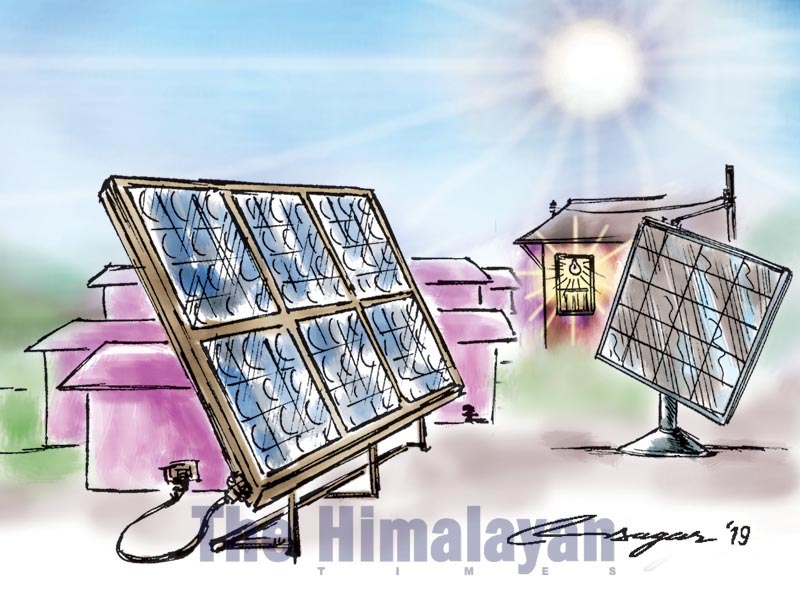Solar energy: Nepal’s most sustainable resource
Solar energy is by far the largest and most sustainable energy resource in Nepal. Nepal is a country with high solar potential, moderate hydro resources and small wind and bio energy resources. Hydroelectricity struggles to compete with the flexibility and low-cost of solar, particularly because the cost of solar continues to decline
Nepal has enormous and low-cost solar energy resources. The solar potential in Nepal is 50,000 terawatt-hours per year, which is 100 times larger than Nepal’s hydro resource and 7,000 times larger than Nepal’s current electricity consumption.
Solar can easily meet all future energy needs in Nepal.
Solar energy is cheaper than fossil fuels, nuclear and hydro. According to the 2020 World Energy Outlook from the International Energy Agency, “For projects with low cost financing that tap high quality resources, solar PV is now the cheapest source of electricity in history”.
Energy from coal, oil and gas is the primary cause of climate change. However, a radical transformation of the global energy system is underway. Solar photovoltaics and wind now comprise two-thirds of global net new electricity generation capacity additions because they are cheap. Deep renewable electrification of energy services, including transport, heating and industry, allows solar and wind to eliminate fossil fuels over the next few decades.
According to the Intergovernmental Panel on Climate Change, to limit global warming to 1.5 degrees Celsius, rapid reductions in greenhouse emissions are required. Because solar energy is so cheap, developing countries such as Nepal can bypass a fossil fuel era and transition directly to zero emission solar.
Very rapid reductions in the price of solar over recent years open enormous markets in developed and developing countries alike.
The solar resource in Nepal is good enough for the production of electricity at a cost of NRs 4,800 (US$40) per MWh once the solar industry becomes mature in Nepal, falling to below NRs 3,600 (US$30)/MWh in 2030.
Solar energy is by far the largest and most sustainable energy resource in Nepal.
Nepal is a country with high solar potential, moderate hydro resources and small wind and bio energy resources. Hydroelectricity struggles to compete with the flexibility and low-cost of solar, particularly because the cost of solar continues to decline. And solar energy has far lower environmental and social impact than damming Himalayan rivers.
Small-scale solar systems for individual households or villages provide electricity for lighting, computing, telecommunications, water pumping, grain grinding and refrigeration. Small amounts of solar electricity cost relatively little but make a large difference to living standards. As living standards rise, families can purchase more solar panels to mount on their rooftops.
This incremental growth in solar energy capacity allows energy supply to increase in step with family income.
In the future, the Nepali people can expect to achieve a much higher living standard. When Nepal catches up with the developed countries, each person will consume about 15 megawatt-hours per person per year of electricity, which is 70 times larger than today. Clean solar electricity will be used to light and heat homes, cook food, power electric vehicles and drive industry, just like in the developed countries.
Over the next 50 years, Nepal will need to install 200 watts of solar panels per person each year (about one square metre of panel per person per year).
This is a similar deployment speed as in Australia, where deployment of solar and wind systems is driving down the cost of electricity.
All parts of Nepal are favourable for solar energy.
The area of solar panel required to match the energy consumption per person in developed countries is 40- 50 square metres per person with a nominal power capacity of about 10 kilowatts.
Much of this solar panel area can be located on rooftops. Some can be on the ground. Some can be floated on lakes and hydroelectric reservoirs. Some solar systems can be located in food growing areas (agrivoltaics) where widely spaced solar panels shade 10 per cent of the crop but cause little loss of production because they reduce wind speeds and evaporation rates.
Balancing high levels of solar energy over every hour of every year is straightforward. Strong transmission across Nepal allows the smoothing out of local weather and demand variability. Storage via pumped hydro energy storage and batteries allows the daily solar cycle to be accommodated.
Pumped hydro energy storage is far cheaper than batteries, hydrogen or other storage technologies for overnight and longer-term storage, which is why it has 95 per cent of the global storage market.
According to the Global Pumped Hydro Atlas, Nepal has 2,800 good storage sites, which is 50 times more than needed even after Nepal catches up with the developed countries.
Importantly, none of these sites requires any rivers to be dammed, which eliminates a high environmental and social cost.
Most of the major economies around the world have pledged to reach zero greenhouse emissions by 2050. This requires the solar industry to become 30 times larger during the 2020s. Because of this massive scale-up, the price of solar panels will halve again, and the cost of solar energy in Nepal will decline far below any other energy source.
Solar energy has far lower risk because solar panels can be installed incrementally.
The era of hydroelectricity from damming rivers is ending.
The speed of development of the global solar industry and the rapid price reductions are so fast that previous reports on energy options for Nepal require updating.
Solar energy in Nepal is abundant and cheap. There is more than enough solar energy for every Nepali to enjoy the same energy consumption as in the developed countries, but without burning any fossil fuels or damming any Himalayan rivers.
Blakers is a Professor at the Australian National University and Lohani is an Associate Professor at Kathmandu University






